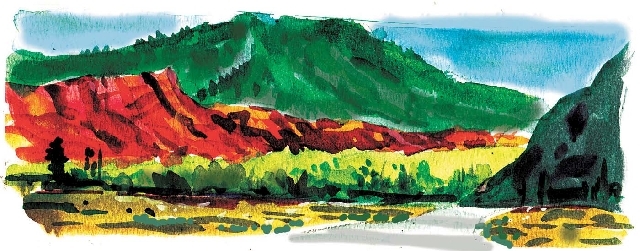Vivid sandstone, history color Utah’s Red Cliffs

Southern Utah’s dramatic geological features and vividly colored sandstone formations invite visitors to explore and take a closer look.
Major highways lead to the best-known destinations, but the less-traveled side roads often reveal places of extraordinary beauty and fascinating glimpses of the past. One enticing area lies along Interstate 15 near the pioneer-era community of Leeds, about 15 miles north of St. George and just a two-hour drive from Las Vegas.
Set aside as Red Cliffs National Conservation Area, the large desert reserve contains colorful cliffs, hidden canyons, lively creeks, ghost towns, a network of trails, ancient Anasazi ruins, dinosaur tracks and picnic and camping areas.
Carving their way through the sandstone within a few miles of each other, Leeds Creek and Quail Creek used to feed directly into the Virgin River to the east. Today, the water is caught behind a dam to create Quail Creek Reservoir in a popular state park. The creeks foster lush riparian areas and shady groves of trees.
The Bureau of Land Management maintains Red Cliffs Recreation Area within the national conservation area. To reach this scenic region, turn off the freeway at exit 22. Turn right on the frontage road and drive south for two miles. The paved Red Cliffs access road turns west and runs beneath the freeway in two tunnels. The recreation area is a short drive from the freeway.
As you continue west, watch for a sturdy little stone house in what used to be an agrarian settlement called Harrisburg. Built by pioneer Anson Adams in 1863, the modest home, representative of Mormon frontier construction, was rehabilitated in 2006. It sits on 215 acres of historic farmland, including stone-fenced pastures, terraced gardens and old orchards. The grounds are open to visitors, but the interior of the house is not yet ready. Parking is limited.
Continue to the recreation area, which is open year-round. It has a day-use area with picnic facilities, a 33-space parking lot and access to several trails. There is a $5 fee, but it is waived for holders of federal recreation passes.
The Red Cliffs campground has 11 sites for tents or RVs, available on a first-come basis for a nightly fee of $15; pass holders pay half price. Both the day-use area and the campground have water and vault toilets, but there are no RV hookups.
If visitors follow a half-mile trail to the Red Cliffs Archaeological Site, they will see ruins of a small community of Anasazi, who were drawn to the area by the water. They farmed small plots, hunted and gathered natural foods. Another short trail leads to a grand overview of the sandstone ledges, or reefs, characteristic of the area. This trail runs past areas where dinosaur tracks from the Jurassic Period have been found. Another more challenging trail takes hikers or horseback riders six miles into the Cottonwood Wilderness Area.
Obtain detailed maps of these and other trails at the interagency visitor center in St. George on Riverside Drive off the Bluff Street Exit.
Harrisburg, Leeds and other Mormon towns provided food and supplies to prospectors and miners after unusual deposits of silver were discovered in the sandstone reefs near Red Cliffs in 1866. The boomtown of Silver Reef grew into a community of about 2,000 people when the mines and mills operated, but the boom had ended by 1884, with a few weak revivals following into the mid-1900s.
To reach Silver Reef, retrace the Red Cliffs route from exit 22. You can return to I-15, drive north and take exit 23, or follow the frontage road north through Leeds to Silver Reef Road.
When Silver Reef fell on hard times, most of its buildings were dismantled or sold for scrap. Foundations, partial walls and a few original buildings remain, including the Wells Fargo office with its grand old safe. The building now houses an art gallery and museum exhibits that continue outside with vintage mining equipment and vehicles. Modern residences crowding up to the old main street indicate Silver Reef’s population is growing again.
Margo Bartlett Pesek’s Trip of the Week column appears on Sundays.